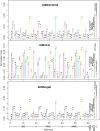Predicting antimicrobial peptides with improved accuracy by incorporating the compositional, physico-chemical and structural features into Chou's general PseAAC
- PMID: 28205576
- PMCID: PMC5304217
- DOI: 10.1038/srep42362
Predicting antimicrobial peptides with improved accuracy by incorporating the compositional, physico-chemical and structural features into Chou's general PseAAC
Abstract
Antimicrobial peptides (AMPs) are important components of the innate immune system that have been found to be effective against disease causing pathogens. Identification of AMPs through wet-lab experiment is expensive. Therefore, development of efficient computational tool is essential to identify the best candidate AMP prior to the in vitro experimentation. In this study, we made an attempt to develop a support vector machine (SVM) based computational approach for prediction of AMPs with improved accuracy. Initially, compositional, physico-chemical and structural features of the peptides were generated that were subsequently used as input in SVM for prediction of AMPs. The proposed approach achieved higher accuracy than several existing approaches, while compared using benchmark dataset. Based on the proposed approach, an online prediction server iAMPpred has also been developed to help the scientific community in predicting AMPs, which is freely accessible at http://cabgrid.res.in:8080/amppred/. The proposed approach is believed to supplement the tools and techniques that have been developed in the past for prediction of AMPs.
Conflict of interest statement
The authors declare no competing financial interests.
Figures





Similar articles
-
An advanced approach to identify antimicrobial peptides and their function types for penaeus through machine learning strategies.BMC Bioinformatics. 2019 Jun 10;20(Suppl 8):291. doi: 10.1186/s12859-019-2766-9. BMC Bioinformatics. 2019. PMID: 31182007 Free PMC article.
-
PTPAMP: prediction tool for plant-derived antimicrobial peptides.Amino Acids. 2023 Jan;55(1):1-17. doi: 10.1007/s00726-022-03190-0. Epub 2022 Jul 21. Amino Acids. 2023. PMID: 35864258
-
DPP-PseAAC: A DNA-binding protein prediction model using Chou's general PseAAC.J Theor Biol. 2018 Sep 7;452:22-34. doi: 10.1016/j.jtbi.2018.05.006. Epub 2018 May 16. J Theor Biol. 2018. PMID: 29753757
-
Computational resources and tools for antimicrobial peptides.J Pept Sci. 2017 Jan;23(1):4-12. doi: 10.1002/psc.2947. Epub 2016 Dec 14. J Pept Sci. 2017. PMID: 27966278 Review.
-
A review on antimicrobial peptides databases and the computational tools.Database (Oxford). 2022 Mar 19;2022:baac011. doi: 10.1093/database/baac011. Database (Oxford). 2022. PMID: 35305010 Free PMC article. Review.
Cited by
-
Carboxypeptidase inhibitors from Solanaceae as a new subclass of pathogenesis related peptide aiming biotechnological targets for plant defense.Front Mol Biosci. 2023 Nov 16;10:1259026. doi: 10.3389/fmolb.2023.1259026. eCollection 2023. Front Mol Biosci. 2023. PMID: 38033385 Free PMC article.
-
Perspectives in Searching Antimicrobial Peptides (AMPs) Produced by the Microbiota.Microb Ecol. 2023 Dec 1;87(1):8. doi: 10.1007/s00248-023-02313-8. Microb Ecol. 2023. PMID: 38036921 Free PMC article. Review.
-
Are peptides a solution for the treatment of hyperactivated JAK3 pathways?Inflammopharmacology. 2019 Jun;27(3):433-452. doi: 10.1007/s10787-019-00589-2. Epub 2019 Mar 30. Inflammopharmacology. 2019. PMID: 30929155 Review.
-
The Road from Host-Defense Peptides to a New Generation of Antimicrobial Drugs.Molecules. 2018 Feb 1;23(2):311. doi: 10.3390/molecules23020311. Molecules. 2018. PMID: 29389911 Free PMC article. Review.
-
iRSpot-Pse6NC: Identifying recombination spots in Saccharomyces cerevisiae by incorporating hexamer composition into general PseKNC.Int J Biol Sci. 2018 May 22;14(8):883-891. doi: 10.7150/ijbs.24616. eCollection 2018. Int J Biol Sci. 2018. PMID: 29989083 Free PMC article.
References
-
- Porto W. F., Souza V. A., Nolasco D. O. & Franco O. L. In silico identification of novel hevein-like peptide precursors. Peptides. 38, 127–136 (2012). - PubMed
-
- Yeaman M. R. & Yount N. Y. Mechanisms of antimicrobial peptide action and resistance. Pharmacol. 55, 27–55 (2003). - PubMed
-
- Brogden K. A. Antimicrobial peptides: pore formers or metabolic inhibitors in bacteria? Nat. Rev. Microbiol. 3, 238–250 (2005). - PubMed
Publication types
MeSH terms
Substances
LinkOut - more resources
Full Text Sources
Other Literature Sources
Miscellaneous

